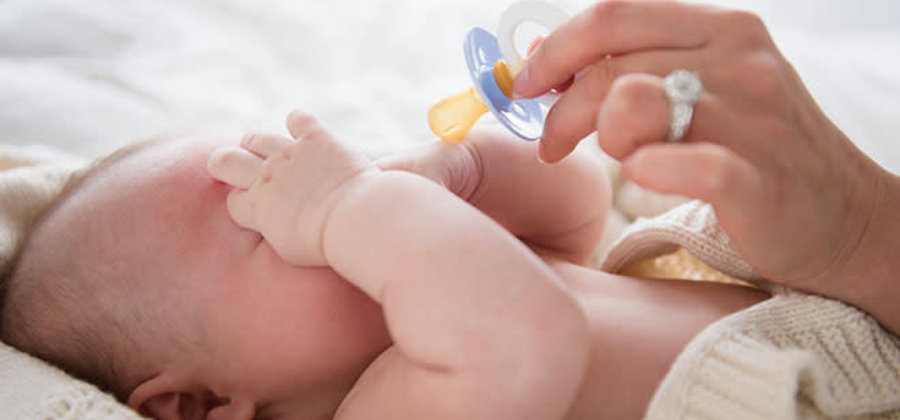
According to the National Library of Medicine1, anywhere from 58-85% of infants in the United States use a pacifier at some point. By far the most popular time for a baby to use a pacifier is around 3-4 months of age.
Some babies stop on their own, or don’t need it once they find other ways to self-soothe. However, some children love their ‘binky’ and may use it through toddler years, too.
That being said, prolonged use of pacifiers could be a concern. Research shows that using a pacifier after the age of 4 or 5 could lead to dental problems, speech delays or increased ear infections.
If your child is in the early stages and likes using a pacifier, don’t stress over it. You can start the weaning process gradually.
Now, if your little one has never used a pacifier and you want to avoid it, my list has some great alternatives to help you skip the paci altogether. Moreover, these pacifier alternatives will also help you during the weaning process and make it easier for baby to sleep without pacifier.
This article is not a substitute for medical advice or consultation.
Weaning Pacifier
While this post is all about pacifier weaning systems and when a child’s pacifier use should be limited, I want to add that I am not against the use of pacifiers with infants.
There are benefits to using pacifiers, for sure.
Benefits Of Pacifiers
There are times when parents might actually prefer using a pacifier: as an alternative to thumb-sucking or during air travel.
The sucking motion can reduce pressure in the ears, or help calm an infant who is unwell.
There’s nothing to be ashamed of if your baby likes using a pacifier, it’s a very normal comfort to infants.
Pacifier Alternatives
This post is for parents who want to avoid using pacifiers, for their own reasons, or those who have children close the age when pediatricians recommend weaning off of the pacifier.
Some babies “grow out” of pacifier sucking without active weaning from parents – this can happen at any age. They may find other means of self-soothing, like a lovey or stuffed animal, instead. Other toddler, however, may need some soft of pacifier alternative to make the weaning process easier.
When To Start Weaning Off The Pacifier?
The American Academy of Pediatrics advises pacifier use stop by age four, because prolonged pacifier use can lead to inner-ear infections, speech delays and dental problems2.
If your child is younger or still an infant, take heart – you have a long timeframe to gradually wean your baby off the pacifier.
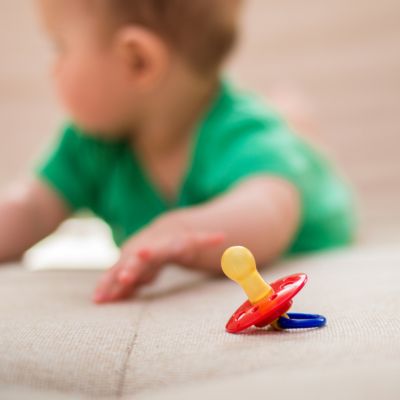
Why Babies & Toddlers Like Pacifiers
There are several reasons babies like pacifiers, but the most common are for comfort or to self-soothe.
-
Comfort
Breastfed babies often enjoy comfort nursing; the sucking sensation can be very calming, but it can lead to over-eating if you don’t limit it. Introducing a pacifier allows for the comforting sucking, without the extra breastmilk.
-
Transitioning Off The Bottle
A pacifier can also be used when bottle weaning.
If you need to transition your toddler away from a bottle and to learn to use a sippy cup, you may find a pacifier is helpful to get them to fall asleep at night, since they may be missing the familiar comfort of a bottle before bed.
-
Soothing Babies
Pacifiers work like a charm to help an upset baby calm down quickly. There are another ways though, to soothe a crying baby; we’ll get into the alternatives, below.
-
Teething
It can be downright painful for babies to develop their first “baby teeth”. Babies may reach for pacifiers to use as a type of teething toy to soothe sore gums.
While babies might LIKE to use their soothers as a teethers, this is not safe. Read on to understand why.
-
Air Travel
It’s a common ‘travel hack’ with babies to use an artificial nipple or pacifier during flight take-offs and landings. The suckling motion of the jaw helps to relieve the pressure the builds up in the ears when changing altitude rapidly.
Since babies don’t know how to “pop their ears”, comfort nursing or sucking on a pacifier is an easy way to prevent pain in the ears when flying.
-
Illness
Some parents opt for limiting pacifier use except when a baby is unwell.
If you are dealing with a fussy baby due to fever, or you’ve experienced colicky babies, you can understand why a pacifier can help with calming babies.
-
Alternative To Thumb Sucking
Some babies will try for the sucking satisfaction, even if they don’t have a bottle or a pacifier on-hand; they will start sucking their thumb.
And while it can be a form of self-soothing, if your child continues thumb sucking for a long time, it can lead to speech problems or middle ear infections, just like with prolonged pacifier use.
In addition, toddlers touch everything at the supermarket, run their hands on germy rails at the park and insist on pushing elevator buttons – most moms do not want their toddlers to be sucking on their unwashed thumbs!
When given the choice, many parents prefer a pacifier in this scenario, in order to keep their child from getting sick.
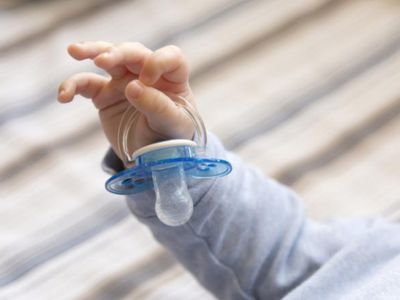
Reasons To Choose Pacifier Alternative
If your baby has never used a pacifier and you don’t want to start now, or your little one constantly wants their soother and you’re concerned about the long-term effects, here are some good reasons to choose alternatives.
-
Concerns About Nipple Confusion
Nipple confusion is when a young baby struggles to transition between breastfeeding and using a bottle. While some moms may opt for pumping breast milk, sometimes it is a temporary feeding approach.
If a mother wants to go back to nursing after introducing a bottle, some babies struggle to make the transition and have what is called “nipple confusion”.
While this is primarily connected to bottles, it can also occur with pacifier use. Restricting or weaning pacifiers can help in some cases of nipple confusion.
-
To Avoid Prolonged Use
Research shows that using pacifiers for consecutive years can have negative consequences including: problems with child’s teeth, speech delays, or frequent middle ear infections. Breaking the pacifier habit before they reach age 4 is important to prevent these issues.
TeethingWhile a baby may find a pacifier soothing during the teething phase, a “dummy” or “binky” is not a teething toy. Many parents find that a toddler will chew on their pacifier.
Baby’s new sharp teeth can pose a real choking hazard if they chew off small pieces of the silicone nipple.In such cases, it’s a good idea to introduce safe teething toys, instead.
-
Child’s Age
As mentioned above, The American Academy of Pediatrics advises stopping pacifier use by the age of 4 to avoid the potential risks mentioned above. You may want to consider pacifier alternatives before they reach this age.
-
You’re Tired Of Picking Up Dropped Pacifiers
Being sick and tired of picking up dropped pacifiers or replacing the continually lost pacifiers is a completely valid reason to choose pacifier alternatives!
You would do anything for your kid, I know, but the number of pacifiers dropped under their crib should also not be a risk to your own sanity.
-
Your Little One Doesn’t Keep Pacifier In Mouth While Sleeping
During sleep baby’s muscles in the of the jaw relax, which makes the pacifier to fall out. This often leads to baby waking up and crying. You can avoid that by using a paci alternative (and check out my article about keeping pacifier in baby’s mouth in a safe way).
When To Offer Pacifier Alternative?
Parents can start pacifier alternatives at any age, even with a newborn baby. Choosing pacifier alternatives comes down to your child’s age, development and preferences.
Please pay attention to your child’s age, because toddlers pacifier alternatives may not be appropriate for a newborn.
Remember to take safety precautions for sudden infant death syndrome until your child is over 12 months old: do not offer a comfort blanket for a newborn to sleep with, swaddle them instead.
The American Academy of Pediatrics advises that children should stop using a pacifier by age 4. If your baby is still using a paci, but is years away from that age marker, don’t stress – you have plenty of time to start weaning gradually and find pacifier alternatives that work for you.
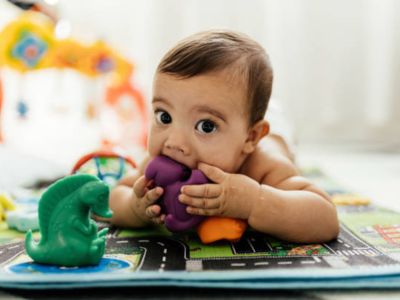
How Can I Soothe My Child Without A Pacifier? – 24 Best Pacifier Alternatives
I’ve separated this list by age: suggestions for newborns, older babies and appropriate pacifier alternatives for toddlers, too.
Choose the best approach based on your child’s individual needs and developmental stage3.
Newborns
Newborns primarily use a pacifier for comfort. Therefore, offer soothing alternatives to pacifiers:
1. White noise machine
2. Swaddling
Wrap in a swaddle until they learn to roll over, then transition to a sleep sack for safety.
3. Cuddle with mom
4. Skin to skin contact
All of these approaches are proven by research to soothe babies. Many parents opt not to use a pacifier with a newborn, so that they can pay attention to hunger cues, such as rooting, which is more difficult to detect when a baby has a pacifier in their mouth.
Babies From 4-9 Months
Infants at this age are likely choosing a pacifier as a form of self-soothing.
While they may not be interested in stuffed animals just yet, there are plenty of other means you can use to help you child learn to self-soothe without a pacifier.
You can still use the white noise machines, or go for one of these best pacifier alternatives:
5. A familiar bedtime routine
6. Sleep in a sleep sack or baby-safe sleeping bag
7. Soft toy or security blanket
Keep in mind it’s safe to use it only during awake hours.
8. Clothing that smells like mom or dad
Never in the crib, though! No bedding until at least 12 months old.
9. Rocking or cuddling
10. Baby swing
Basically, you want to look for a way to soothe your baby that is not with a paci. A crying baby may enjoy the rocking motion of a baby swing, or the soothing sound of your voice making a shushing noise.
Babies From 9-18 Months
Young toddlers may need an alternative to a pacifier that goes beyond the soothing and considers meeting their sensory-seeking behavior.
An infant who is seeking sense stimulation may not feel satisfied with a sound or noise, such as a white noise machine or mom’s singing. Hence, offer a physical item they can hold or chew on.
Your baby may also have started teething at this age, so getting something that goes in their mouth may be the necessary alternatives to pacifiers that will really soothe those swollen gums.
Look for alternatives that hit the physical senses, like:
11. Teethers
Go for teethers that fit the shape of their mouth – no sucking, but chewing instead.
12. Teething toys
I love teething rings, keys or ones that go in the fridge/freezer to a nice cooling effect.
13. Finger tooth brush
These silicone shapes fit on the end of an adult finger and can be soothing (and hygienic!) during the teething phase.
However, never give your child the finger toothbrush to play with unsupervised – this can pose a choking hazard. Always assist your child and use your own finger inside the finger brush.
14. Baby tooth brush
15. Silicone or natural rubber toys
Look for ones that are safe for babies to chew and suck to their heart’s content.
16. Sensory toys with different textures that can be easily washed
The idea here is to meet your child’s sensory needs, including the desire to suck and chew, without opting for a pacifier.
17. Chewable blanket (teething blanket)
I know, those words don’t sound like they go together, but this is a big hit with babies 6-10 months old who are thick in the teething phase. It’s got the soft, comforting features of a little blanket, but with textured corners designed for chewing.
Just make sure you’re choosing machine-washable blanket!
18. Pacifier transition items (lovey)
Another paci alternative is a soft toy (sometimes called a “lovey”) that can be connected to pacifier.
You remove the pacifier, either all together or in incriments, until it is completely absent and the baby remains with the soft toy. This is a gradual approach to weaning a baby off the pacifier.
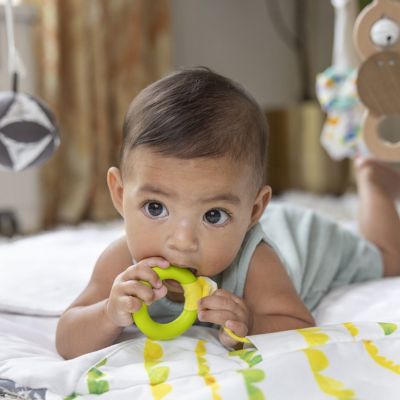
2 Years – Older Children
Children two years old and beyond may need different approaches for the weaning process. Skin-to-skin contact and swaddling are not going to work with an active toddler!
Some parents decide to go cold turkey, skipping any weaning systems. While this is a fair approach, remember to watch out for thumb sucking as an alternative to pacifiers, too.
Here are my top suggestions for pacifier alternatives for toddlers:
19. A New Toy
Consider letting your child select their own new toy to replace their pacifier.
20. Big kid comfort items
At this age, they can sleep with a blanket or a “lovey” at night. A favorite stuffed animal can be a great comfort item for toddlers.
21. Night light in the bedroom
If your big kid struggles to fall asleep or your child wakes frequently at night, you might want to consider making your child’s room more comforting – add a night light or set up a white noise machine to muffle outside noises.
22. Safety blanket
Your child is now old enough to sleep with a blanket or a sleeping bag, so let them choose their favorite character or color as a means of transitioing their preferred comfort item away from the pacifier.
23. Sippy Cup
There’s plenty of quality water bottles or sippy cups that have silicone straws or flat mouth pieces.
These items allow for the sensation in their mouth, but with extra advantages: increased hydration and not shaped like a nipple!
24. Toothbrush
Toddlers can also use a toothbrush in place of a pacifier, and it makes a great opportunity for parents to encourage good dental hygiene, too!
Can A Baby Do Without A Pacifier?
Yes, baby can do without pacifier!
While the majority of babies will use a pacifier at some point, if your baby doesn’t want it, that’s fine! A baby without a pacifier isn’t an issue at all.
Does Montessori Allow Pacifiers?
In general, Montessori approaches discourage the use of pacifiers.
The ideal here is to help your baby learn other means of self-soothing and independence.
Montessori advises parents to avoid pacifier use all together.
The purpose of this article is informative. It’s not a substitute for professional medical advice or medical care. Remember: safety first! Consult your doctor/pediatrician in case of any doubts. The author of this article does not accept any responsibility for any liability, loss or risk, personal or otherwise, incurred as a consequence, directly or indirectly, from any information or advice contained here.
References:
https://www.ncbi.nlm.nih.gov/
https://healthychildren.org/
https://montessori-academy.com/
https://lovevery.com

